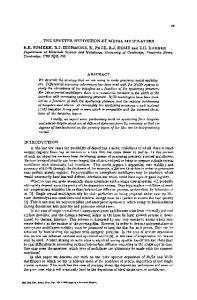Metal / Silicon Multilayers Produced by Low-Temperature MOCVD
- PDF / 1,261,870 Bytes
- 6 Pages / 391.5 x 607.5 pts Page_size
- 49 Downloads / 463 Views
ABSTRACT W/Si and Mo/Si multilayers with 20 periods (doublelayer spacing d = 24nm) were deposited on silicon substrates using (remote-) plasma-enhanced MOCVD. The substrate temperature was below 2000 C, which is necessary to avoid interdiffusion of the layers. The layer thickness and growth was controlled by an in situ soft x-ray reflectivity measurement. The characterisation of the multilayers showed an excellent growth of the silicon layers, while the metal layers are rough with embedded crystallites.
INTRODUCTION Multilayers with a layer thickness of some nanometers are important for optical applications in the soft x-ray spectral region. Due to the optical constants of all materials in this wavelength range, transmissive optics are impossible, and multilayer mirrors are the only way to achieve sufficient high reflectivities at normal incidence, as they are needed for optical elements [1,2]. Molybdenum / silicon multilayers are of a special interest, since this material combination can provide high reflectivities at 13nm wavelength [3]. Another important combination of materials is tungsten / silicon. The reflectivities that can be reached with W/Si are much lower, but this system has proven to be much more stable under thermal treatment [4]. In all cases very smooth layers are needed to obtain high reflectivities. The interface imperfections are given by rough growing layers, by diffusion processes between the different materials, or both. All multilayer systems for soft x-ray optics are commonly deposited by different physical vapor deposition (PVD) methods, such as electron beam evaporation [3], sputtering [5] or laser evaporation [6]. In this work, we try to introduce chemical vapor deposition (CVD) as additional method for the deposition of metal / silicon multilayers, to combine the advantages of CVD (uniform film deposition even on complex shaped substrates, high growth rates, high throughput, large area deposition, selective deposition on a substrate) with the accuracy of PVD deposition. To avoid special security measures, we only used non-hazardous metal-organic and siliconorganic precursors, respectively. Metal organic chemical vapor deposition (MOCVD) has the disadvantage of possible carbon contaminations of the layers, which might lead to a reduced reflectivity. But the advantages of easy handling make MOCVD a good choice anyway. For metal deposition commercially available hexacarbonyles W(CO) 6 and Mo(CO) 6 were chosen [7,8]. A good organic alternative for the commonly used silane (SiH 4) are cyclopentadienyl substituted silanes [9,10]. In this work pentamethylcyclopentadienyldisilane (C5Me 5)Si2H5 was used. This precursor, specially developed for this purpose, showed the highest deposition rates (up to 1Onm per second) at the lowest substrate temperatures (500C) of all tested cyclopentadienyl substituted silanes [11 ]. For the deposition of metal/silicon multilayers with smooth interfaces the substrate 19 Mat. Res. Soc. Symp. Proc. Vol. 555 ©1999 Materials Research Society
temperature is essenti
Data Loading...






